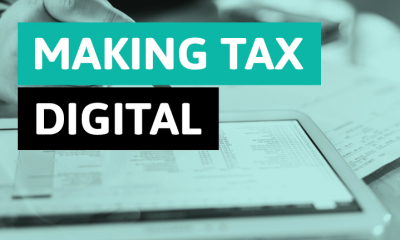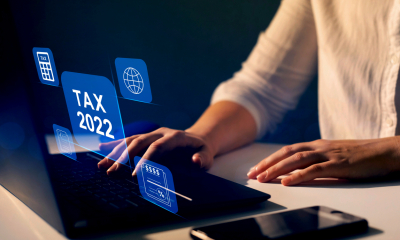
All VAT-registered businesses must follow the Making Tax Digital (MTD) rules. Making Tax Digital is being rolled out to income tax from April 2026 and will eventually be rolled out to corporation tax, too.
The aim of MTD is to make record-keeping – and filing your returns with HMRC – easier. With the right software, you should not have any problems complying with the requirements of MTD for VAT.
How does making tax digital work?
Do I need to register for MTD for VAT?
Making Tax Digital software requirements
1 How does MTD for VAT work?
Making Tax Digital means that you have to deal with tax records and returns digitally
The basics of VAT – such as when you need to register, how you charge and reclaim VAT, and so on – remain the same.
If you are registered for VAT, you must keep digital records
- You can do this using MTD for VAT compatible software, or an alternative (such as a spreadsheet) together with software that connects it to HMRC's systems.
You must prepare VAT returns using the information in your digital records
- Your software should be able to prepare the return for you.
- You declare that the information is correct and submit it.
- You must file your returns online through HMRC's platform.
2 Do I need to register for MTD for VAT?
Making Tax Digital applies to all businesses registered for VAT unless you are exempt
- This includes businesses that are voluntarily registered for VAT.
- You are automatically exempt if you are already exempt from filing VAT returns online, or if your business is going through insolvency.
- You can apply for exemption if MTD for VAT is impractical. For example, because there is no internet access where you are, or because you have a disability that makes it unreasonable to expect you to use a computer.
- You can also apply for exemption if you have religious objections to using computers.
You need to register online
- You must have MTD for VAT software before you register.
- You register using your Government Gateway online account. If you don't already have a user ID and password, you can set them up as part of the process.
- You'll need details of your VAT registration and your business (eg company registration number and Unique Taxpayer Reference, or your National Insurance number if you are a sole trader).
3 Making Tax Digital software requirements
You must keep your VAT records using compatible accounting software – rather than a paper-based system.
The easiest option is to use software that also allows you to submit your VAT returns online
- Modern online small business accounting packages are MTD-compatible and generally easy to use.
You may want to continue using a different type of record-keeping software
- For example, if you are used to tracking your finances using a spreadsheet.
- If you take this approach, you will need to get 'bridging' software that can connect these records to HMRC.
- Switching to software designed for handling VAT may be a better solution.
The system you use must be fully digitally linked
- You cannot manually copy data from one part of your accounting system to another. For example, if you use a spreadsheet to record your invoices, you cannot then manually transfer the total into another piece of software used to file your VAT return.
- Automatically exporting and importing data qualifies as a digital link as does linking cells between spreadsheets. Manually copying and pasting data does not.
- Accounting software designed to work with Making Tax Digital should automatically satisfy this requirement.
- You may want to take advice from your accountant on what software to use.
4 VAT records
You must keep digital records of basic information about your business
- Your business name and address.
- Your VAT registration number.
- Whether you use any VAT accounting schemes such as flat rate or cash accounting.
You must keep digital records of sales and purchases
- This also applies to other types of 'supply' that are included in your VAT return, such as hiring goods or services.
- For each supply, you must record the tax point (time of supply), value excluding VAT and VAT rate charged.
- If an invoice includes multiple supplies at the same rate of VAT, these can be recorded as a single entry.
The exact requirements vary if you use any accounting schemes
- You can find detailed digital record-keeping requirements in VAT Notice 700/22: Making Tax Digital for VAT.
You must keep copies of invoices you issue or receive
- You can still keep paper invoices as proof of transactions – you do not need to scan them.
- The same applies for other records such as bank statements or till rolls.
5 Filing your VAT return
VAT software should make it easy for you to file your return online
- The software automatically links to HMRC's systems.
- The first time you link to HMRC, you need to enter the Government Gateway details for your business. There is a verification process to make sure that the software is authorised to submit VAT returns for you.
- The authorisation process will be repeated periodically – perhaps every 18 months or when software is updated.
Your accountant can file your return for you if you want
- Many small businesses keep VAT records themselves, but then get the accountant to check and file the return.
- To file your returns, their systems must be digitally linked to your records. The easiest option can be cloud accounting software, where both you and your accountant have access to the same system.
- You must authorise your agent to file the return for you. Your agent emails you a link which you can use to do this online.
Find out more about how to file a VAT return for MTD.
Signpost
- Find more detailed guidance in VAT Notice 700/22: Making Tax Digital for VAT.
- Find software that's compatible with Making Tax Digital for VAT.
- Apply for an exemption from MTD for VAT.
- Register online for MTD for VAT.
- Find out how to authorise an agent to deal with certain tax services for you.



